Vol 5 No. 34 TROPIC LIGHTNING NEWS September 7, 1970
Index
| Unit Page | Unit Page | Unit Page | Unit Page |
| 12th Evac 6 | 1/5 Photo 1 | 25th Psyops 8 | 4/23 4 |
| 125th Signal 6 | 2/12 Photo 8 | 25th Supply 3 | 4/23 8 |
| 1/27 1 | 2/14 8 | 2/77 7 | 4/9 6 |
| 1/27 Photo 8 | 2/22 3 | 3/22 1 | 725th Maint 8 |
| 1/5 1 |
Two Viet Cong Rally;
Rest Resist
Regulars Coax Reluctant Enemy Out of Hiding
By SP4 KRIS PETERSEN
CU CHI - Two ralliers were glad to be alive after an encounter with 25th
Division’s Charlie Company, 3rd Battalion 22nd Infantry,
working east of the French owned rubber plantation recently.
The Regulars were preparing to begin the day’s activities when the point
element suddenly noticed seven Viet Cong crossing the open field to their front.
"At first, I thought they were ARVN, because they didn’t get down
when they first saw us," recalled Private First Class Charles Boyle of Detroit.
Immediately realizing that the seven individuals weren’t friendlies, the
Regulars opened up with a heavy volume of suppressive fire and wounded one individual in
the initial contact. Gunships, and later artillery, pounded the area where the VC were
hiding.
Charlie Company then formed on line to sweep the open area. As they did, one
enemy surrendered immediately. Speaking through a Kit Carson Scout, the newly acquired
rallier informed Captain James K. Skiles, company commander, that "four others (VC),
were still in there, all armed with AK-47’s"
"Using the buddy system, we had the ralliers try to coax his buddies out
of hiding and join him:, said Specialist 4 Jerry (Tex) Franklin, of Ravia, Okla.
"However, the attempt was unsuccessful and then we had to go in and get them using
persuasive methods."
"We stayed in hot pursuit of the fresh tracks left by the Ho Chi Minh
sandals," said Specialist 4 Tommy Tompkins, from Carthage, Tex.
Seeing that the enemy wasn’t about to give up easily, Charlie Company
still tried to take the remaining VC alive. While the company itself circled the enemy,
the Kit Carsons moved out into the open, again trying to persuade the enemy to Chieu-Hoi.
The VC again refused to cooperate and began to fire on the Kit Carson Scouts.
The company reacted immediately, engaging the enemy with small arms fire and killing one
while the others fled.
On a second sweep of the area, the Regulars discovered another enemy hiding
in the thick foliage about 25 yards away from their location. The enemy soldier had stayed
behind to rally when his friends fled. The Kit Carsons interpreted as the Hoi-Chanh gave
valuable intelligence.
"The efforts of our Kit Carsons during the whole operation, was the
major reason for its success," noted Private First Class Don C. Haddock, of Fairfax,
Va.
Division Aids Homeless
Refugees Given New Start
By SGT JACK STRICKLAND
Refugees are the unfortunate by-product of any war, but recently 15,0000
homeless Vietnamese were offered a new start by men of the 25th Division and
their allies.
According to L.M. Smith, civilian refugee advisor for Phuoc Tuy Province,
most of the refugees are Vietnamese nationals who had been living in Cambodia before
increased VC and NVA aggression forced them from their homes.
Side by Side
As the ships carrying the refugees docked at Vung Tau harbor, trucks
awaited them to aid in the next step of their journey home.
Working side by side, ARVN, Australians, and GIs of the 1st
Battalion, 27th Infantry, loaded the families and their belongings aboard the
trucks and transported them to a nearby airport.
"These people are really excited about coming back to Vietnam, "
said Smith.
His words were echoed by an elderly Vietnamese man who told an interpreter
that returning to Vietnam was like being born again.
Sergeant John Musial, a Wolfhound from Trenton, New Jersey was impressed with
the people.
Craftsman and Fishermen
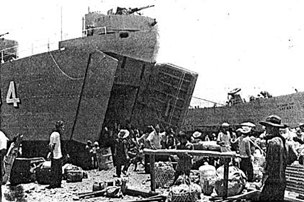 "Most of these people are craftsmen
and fishermen," said Musial. "They should add to the prosperity of any village
they are relocated in."
"Most of these people are craftsmen
and fishermen," said Musial. "They should add to the prosperity of any village
they are relocated in."
Once aboard the airplanes, the refugees were taken to Phuoc Tuy, Binh Tuy,
and Lam Dong Provinces where they will receive identification papers and be relocated in
villages.
"I always like this type of operation," said Wolfhound Private
First Class James Kaltreider of Pittsburg, Pa. "It’s a good way to make friends
and create a better future.
"After all, that’s what we’re here for."
ALL ABOARD – A C-127 cargo planes prepares to
transport Vietnamese refugees to their new homes in the provinces around Vung Tau. (Photo
by SGT Jack Strickland)
Cat Contacts Charlie;
Both Men Backtrack
By SGT BOB LODI
XUAN LOC - In military jargon, "contact" means to engage the
enemy with weapons. But for Specialist 4 Larry Foggin, of Gainsville, Fla., a rifleman
with the 25th Division’s 1st Battalion (Mech), 5th
Infantry, the meaning of "contact" recently took an unmilitary and much more
personal definition.
Gun Falls
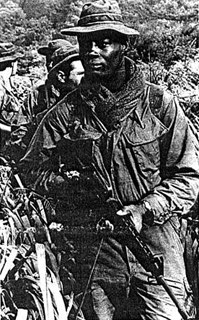 While on a night operation
southeast of Xuan Loc, an element of Bravo Company began to receive rocket grenade fire.
As the APCs (armored personnel carriers maneuvered out of range, and M-60 machine gun fell
off one of the vehicles.
While on a night operation
southeast of Xuan Loc, an element of Bravo Company began to receive rocket grenade fire.
As the APCs (armored personnel carriers maneuvered out of range, and M-60 machine gun fell
off one of the vehicles.
Foggin, seeing the weapon fall, leaped off the track to get it.
"I had moved back to about six feet from the 60 when I bumped into
something," said Foggin.
Much to his surprise, the something turned out to be someone, and Foggin
found himself staring into the dark eyes of a real live Viet Cong.
About Face
Apparently the enemy soldier was as surprised as Foggin, because both
did an immediate about face. Foggin quickly returned to his track and blurted out a
garbled account of the incident and directed fire toward the position of his contact.
Later, Foggin, holding the M-60 he finally rescued, expressed no desire to
repeat the incident.
"I’ve been in some heavy contact before, but this man-to-man stuff
in the dark just don’t get it!"
WARY BOBCATS – Checking in every direction, a column of Bobcats from Alpha Company, 1st of the 5th moves through a series of hills seven miles east of Xuan Loc. (Photo by SP4 Rich Fitzpatrick)
Page 2 TROPIC LIGHTNING NEWS September 7, 1970
Decorated
| SILVER STAR | |
| LTC Ted G. Westerman, HHC, 1st Bn, 5th
Inf CPT Bennet S. Jones, Co D, 2d Bn, 14th Inf CPT Michell C. Meilstrup, Co C, 1st Bn, 5th Inf 1LT Dennis J. Paquet, CRIP, 1st Bn, 5th Inf |
SP4 Terry W. Nichols, Co C, 1st Bn, 27th
Inf SP4 William Slaten Jr, Co C, 3d Bn, 22d Inf PFC Kenneth Korous, Co C, 3rd Bn, 22d Inf PFC Erron Papillion, Co B, 1st Bn, 5th Inf |
BRONZE STAR |
|
| LTC Thomas L. Kelly, HHSB, 2d Bn, 77th Fld Arty 1LT Albert C. Flagg, Co B, 1st Bn, 5th Inf 1LT Gregory L. Solomon, A Btry, 2d Bn, 77th Fld Arty 2LT Cazimer J. Glownia, Co A, 2d Bn, 34th Armor SGM Paul V. Murphy, HHB, 2d Bn, 77th Fld Arty SFC Edward D. Foster, A Btry, 2d Bn, 77th Fld Arty SFC David L. Jones, Co A, 4th Bn, 23d Inf SFC Leroy Thompson, Co C, 1st Bn, 27th Inf SSG Allen H. Erickson, Co D, 65th Engr Bn SSG Thomas V. Forbush, Co C, 1st Bn, 27th Inf SSG Menjamin F. Smith, Co A, 2d Bn, 34th Armor SGT Allen Kouba, Co D, 3d Bn, 22d Inf SP5 Ronald A. Haver, Co D, 65th Engr Bn SP5 Joseph A. Pereira, Co A, 2d Bn, 34th Armor SP5 Robert Rodriguez, Co D, 65th Engr Bn SP4 Gladstone W. Cadle, Co D, 2d Bn, 14th Inf |
SP4 James Doughdrill, Co B, 2d Bn, 27th Inf SP4 James C. Foster, A Btry, 2d Bn, 77th Fld Arty SP4 Edward Holmstrom, A Btry, 2d Bn, 77th Fld Arty SP4 Roger L. Maxwell, Co C, 2d Bn, 12th Inf SP4 Anthony J. Olesh, Co D, 3d Bn, 22d Inf SP4 James Robinson, A Btry, 2d Bn, 77th Fld Arty SP4 Lawrence Tanner , Co D, 65th Engr Bn PFC Stephen L. Burden, Co B, 1st Bn, 5th Inf PFC Joseph P. Duffy, Co D, 2d Bn, 14th Inf PFC Carl J. Hocher, Co B, 1st Bn, 5th Inf PFC Melvin A. Hokanson, Co A, 4th Bn, 23d Inf PFC David C. Hubbard, Co B, 1st Bn, 5th Inf PFC Kenneth L. Johnson, Co A, 2d Bn, 34th Armor PFC Joseph L. Saia, A Btry, 2d Bn, 77th Fld Arty PFC Ralph M. Winters, Co C, 2d Bn, 12th Inf |
Bugs Bug GIs
Critter Control is Critical
By SP4 SCOTT WATSON
What has eight legs, four wings, bites people, lives on garbage, sleeps in
the ground and reads the TLN?
Whatever it is, it can probably be found near Cu Chi someplace. Among the
major problems that servicemen encounter while in Vietnam are insects and rodents.
Most of these pests are dangerous in one way or another. Some bite and others
transfer diseases. Some do both. But for every pest, there is a way to eliminate both its
presence and its danger.
The most dangerous of all insects here in Vietnam is the mosquito. This
insect is well known for its bite and as a carrier of malaria and yellow fever.
It breeds in areas where there is stagnant or standing water. Drainage
ditches and large standing pools of water are places where the mosquito is most apt to
breed.
Destroying these breeding places solves a large part of the problem. Drainage
ditches should be kept clear and any already stagnant pools of water should be covered
with a thin layer of oil, which will eliminate the mosquito’s off-spring.
For personal protection, malaria pills, although they don’t get rid of
pests themselves, do protect the individual from contracting malaria. Also the use of
mosquito netting and insect repellant is highly recommended.
Cockroaches are another familiar sight especially at base camps. They are
associated with the filth insects, such as flies. Although there is no proof they carry
any diseases, their habits and the fact that they live in filth make it a good probability
that they do.
Because they live in filth, it is important to see that all measures of
sanitation are pursued. Garbage and edible wastes should be kept in closed containers,
which in turn should be kept clean. Human wastes should be well disposed of. General
policing of the area is necessary.
Along with improved sanitation measures, cockroaches can be controlled by the
use of insecticides. These are available through unit pest control sections, in a spray
form or a dust (which is used in areas where there is a risk of fire).
"However, it should be remembered that insecticides should be used only
as an addition to sanitary measures and not as a replacement for them," says a
spokesman for the 20th Preventive Medicine Unit.
Flies are known to carry intestinal and other filth-connected diseases. They
can be controlled in the same manner as that of the cockroach.
Rodents and fleas are handled together because of their close association.
They both are known carriers of such diseases as the plague and typhus.
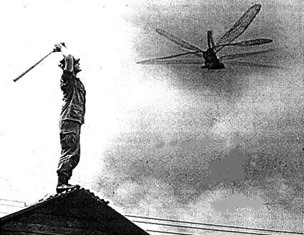 Rodents are found in unsanitary places, such as garbage
and trash pick up points and latrines. However, because of the habits of rodents, they are
fairly easy to control. Once they establish their runways and burrows, they will use these
places until they are forced to move or until they die.
Rodents are found in unsanitary places, such as garbage
and trash pick up points and latrines. However, because of the habits of rodents, they are
fairly easy to control. Once they establish their runways and burrows, they will use these
places until they are forced to move or until they die.
Spreading dust in these areas will kill off the rodents. As they die, fleas
will leave the rodents and after they make contact with the dust, they too will die.
Another important reason for observing sanitation procedures is that Cobras
live on rodents. So it follows, where there are rodents, there may be Cobras also.
THE BIGGER THEY ARE, THE HARDER THEY FALL – An
Admin Company trooper takes pest control into his own hands. No doubt by now he’s
found that it’s much easier to take proper preventive measures before the beasts
arrive than it is trying to eliminate them after they’ve dropped in. (Photo by SP4
Joe Loper)
Tropic Lightning Tots
The Commanding General Welcomes
The Following Tropic Lightning Tots
To The 25th Infantry Division – As
Reported By The American Red Cross.
Born To:
| August 9 PFC Phillip Lee, B Btry, 5th Bn 2d Arty, boy August 13 SP5 Michael Pettengill, 25th Admin Co, boy CPT James K. Stiles, 2d Bn 22d Inf, boy August 14 SP4 Josey W. Clements, B Btry 5th Bn 2d Arty, girl |
August 16 PFC Joseph Cowman, 725th Maint, twin boys August 17 PFC Larry Ramo, B Co 25th S&T, boy |
The TROPIC LIGHTNING NEWS is an authorized publication of the 25th Infantry Division. It is published weekly for all division units in the Republic of Vietnam by the Information Office, 25th Infantry Division, APO San Francisco 96225. American Forces Press Service and Army News Feature materials are used. Views and opinions expressed are not necessarily those of the Department of the Army. Printed in Tokyo, Japan, by Pacific Stars and Stripes.
MG Edward Bautz, Jr . . . . Commanding General
MAJ Robert E. Kelso . . . Information Officer
1LT Martin E. Webb . . . . Officer-in-Charge
SP4 William M. Lane . . . . Editor
SP4 Scott Watson . . . . . . Assistant Editor
SP4 Joseph V. Kocian . . . Production Supervisor
BATTALION CORRESPONDENTS
| SGT Mike Keyster SP4 Tom Benn SP4 Frank Salerno PFC Dan Lowry SP4 Greg Duncan SP4 Rich Erickson SP4 Ed Toulouse SGT Mark Rockney SGT Mike Conroy SGT William Zarrett SGT Daniel House PFC Irwin Polis SP5 Tom Watson |
4/23 7/11 2/22 2/27 2/27 2/14 2/12 2/12 3/4 Cav 4/9 4/9 269th 725th |
SP4 William McGown PFC James Stoup SGT Derr Steadman SP5 Doug Sainsbury SP4 James Duran SGT Jack Strickland SP4 Dan Davis SP4 Kris Peterson SP4 Frank Morris SGT Bob Lodi SGT Dan Davis SGT Byron Fites |
Divarty 65th Eng Discom 2/77 3/13 1/27 1/27 3/22 2/34 1/5 1/27 4/23 |
Page 3 TROPIC LIGHTNING NEWS September 7, 1970
Division Soldiers
Contribute $750
New Vietnamese School Funded by Men of S&T
Story By SGT DERR STEADMAN
The children of Ap Don, a small hamlet near Cu Chi base camp, are soon to
have a school of their own.
"Donations, amounting to more than $750, from the men of the 25th’s
Supply and Transportation Battalion have been used for the purchase of brick and other
building materials not available through regular supply channels," said Sergeant
First Class William H. Hackley of Martinez, Ga.
Hackley, the battalion’s intelligence NCO has, as NCOIC of the school
project, worked with Captain Michael S. Lackey, the civic actions officer from Pine Bush,
N.Y., for almost a month, collecting donations and coordinating the purchase of materials
for the school.
"The brick and mortar and miscellaneous hardware items purchased with
the donated money will be used by Vietnamese masons and carpenters who will do all of the
construction work on the school", explains Hackley.
The men scrounged ammunition boxes from aviation and artillery units in Dau
Tieng and Cu Chi, dismantling and making them into benches, tables and other classroom
furnishings.
A ceremony was conducted recently in Ap Don. The commanding officer of the 25th
S&T, Lieutenant Colonel Joseph L. Van Camp, of South Charleston, W.Va., layed the
first brick of the school’s foundation, initiating the building’s construction.
The school, a two room brick structure with a tin roof, is expected to be
completed and ready for classes to begin by mid-September.
GRATEFUL – (Photo, below right) As the
MEDCAP element of the 2nd of the 22nd leaves Xom Moi, a grateful
villager waves goodbye and thank you for the medical treatment he has received. (Photo by
SP4 Frank Salerno)
GIs, ARVN Get Into Act
ICAP Team Plays Hamlet
By SP4 FRANK SALERNO
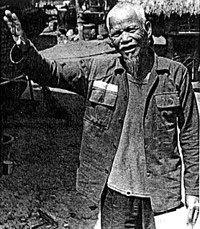 CU CHI – Men of the 2nd Battalion (Mech), 22nd
Infantry’s PSYOPS team are among the most well travelled soldiers in the 3rd
Brigade’s area of operations.
CU CHI – Men of the 2nd Battalion (Mech), 22nd
Infantry’s PSYOPS team are among the most well travelled soldiers in the 3rd
Brigade’s area of operations.
The team currently is conducting ICAPs (integrated civic action projects) in
13 separate hamlets northeast of Cu Chi.
Combined Effort
"With so many hamlets to cover, it requires a combined effort on
the part of U.S. ARVN, and Kit Carson personnel," said 1st Lieutenant
Michael Oliver, the unit’s civic affairs officer.
"To make the ICAPs really effective, we sometimes conduct three or four
operations a day.
"At typical ICAP begins with one of our Kit Carsons speaking over a
loudspeaker to the people of the hamlet, making them aware of the purposes of the
operation. He tells them that they have nothing to fear from the Americans who administer
medical aid to the sick and pass out leaflets to everyone.
Team Effort
"We work as a team to help the villagers in every way
possible," Oliver of Iselin, N.J. continued.
"Besides the medical treatment, we give candy to the kids and cigarettes
to the adults."
The ARVN and Kit Carson Scouts play an important role in the overall
operations. "Having the Vietnamese troops participate increases our chances of
obtaining valuable information from the villagers concerning recent enemy activity in the
area," said 1st Lieutenant Peter Boni, a 6th PSYOPS Battalion
team leader from Boston.
Fruit From Fields
Although ICAPs are not new to some of the hamlets, it has been some time
since the villagers have seen a PSYOPS team. "In several of the hamlets, the people
greeted us with fruit from their fields," said Private First Class Don Deeren, a
Tripple Deuce medic from Sherwood, Mich.
MAIL CALL – (Photo, below right) Tom the
Turkey, who loves to eat letters, heads for mail call at Fire Support Base Warrior. (Photo
by SGT Mark Rockney)
IT’S HAPPENING
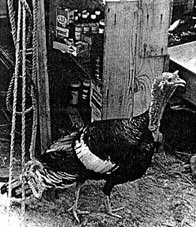 DINNER IS ALIVE AND WELL AT FSB WARRIOR . . . The main
course of a good Thanksgiving dinner has been flying around this base area for three years
now. His name is typically "Tom" and Sergeant First Class Edwin Borrero prefers
to think of him as a pet rather than a meal. Three Thanksgivings ago, Borrero purchased
Tom so that the men of the 2nd of the 12th could celebrate the
holiday in traditional American fashion. But the bird never made it to the table. Tom,
like the Warriors, appreciates a good letter now and then. He eats them. "That’s
his only bad habit," said Borrero rising to the defense of his bird. Things get a
little tense for Tom each year as Thanksgiving draws near. Good luck, Tom. Many happy
returns of the day.
DINNER IS ALIVE AND WELL AT FSB WARRIOR . . . The main
course of a good Thanksgiving dinner has been flying around this base area for three years
now. His name is typically "Tom" and Sergeant First Class Edwin Borrero prefers
to think of him as a pet rather than a meal. Three Thanksgivings ago, Borrero purchased
Tom so that the men of the 2nd of the 12th could celebrate the
holiday in traditional American fashion. But the bird never made it to the table. Tom,
like the Warriors, appreciates a good letter now and then. He eats them. "That’s
his only bad habit," said Borrero rising to the defense of his bird. Things get a
little tense for Tom each year as Thanksgiving draws near. Good luck, Tom. Many happy
returns of the day.
A JOB IS A JOB . . . While purchasing a cold drink
at Cu Chi’s snack bar, we noted with some amusement, the name and position tags of a
couple of the Vietnamese girls who work there. One was "Popcorn Supervisor" and
the other was "Popcorn Operator."
NOW YOU SEE IT, NOW YOU DON’T . . . Beware the
soda and trinket laden children who lurk around mech and legmen. They have been known to
possess extremely light fingers. Not too long ago a certain lieutenant with the 1st
of the 5th had his camera stolen from a jeep along Highway 1 near Xuan Loc.
Searching through all the children’s soda sacks, he came up with nothing. But soda.
Then he had a brainstorm. He walked to the side of the road and began low crawling through
the bushes. There was his camera, carefully hidden. Another man lost his radio and tried
the same trick with less success. All he found was a case of root beer. Keep a wary eye.
Page 4-5 TROPIC LIGHTNING NEWS September 7, 1970
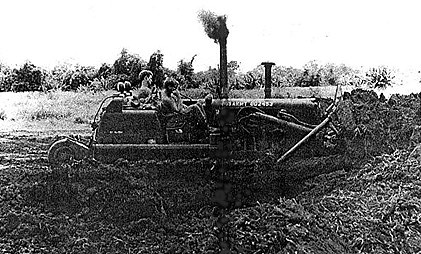 FSB TOMAHAWK – Daily routine tasks such as pulling guard and improving
base defenses are all geared to being on guard against Charlie.
FSB TOMAHAWK – Daily routine tasks such as pulling guard and improving
base defenses are all geared to being on guard against Charlie.
Every day, troops of the 4th Battalion (Mech), 23rd
Infantry perform such routine duties as putting up RPG (rocket propelled grenade) screens,
installing claymore mines and trip flares, setting up radar, improving the berm line and
pulling guard.
It’s all become so routine that most of the Tomahawk infantrymen take
their job for granted.
It’s just something that has to be done. Every day. Despite the mud,
rain or blazing sun.
BERM PROTECTION – (Above right) A bulldozer
scrapes up a protective berm at Fire Support Base Tomahawk for infantrymen of the 4th
Battalion (Mech), 23rd Infantry.
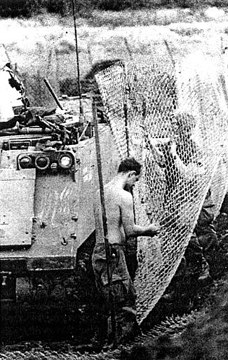
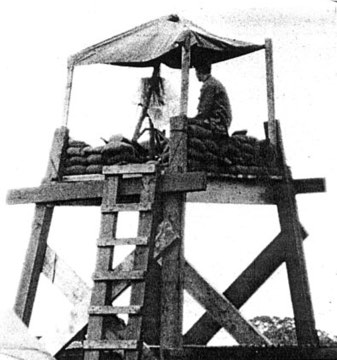 ROCKET RESISTER – (Left) Troops of
the 4th of the 23rd stretch RPG (rocket propelled grenade) screen in
place along a newly formed berm at Fire Support Base Tomahawk.
ROCKET RESISTER – (Left) Troops of
the 4th of the 23rd stretch RPG (rocket propelled grenade) screen in
place along a newly formed berm at Fire Support Base Tomahawk.
CHARLIE WATCHING – (Right) By
day this tower serves as a guard observation post. By night, radar (enclosed in plastic)
takes over the job of Charlie Watching. Tower is at FSB Tomahawk, 20 miles south of Xuan
Loc.
BARBED BARRIER – (Below)
Infantrymen of the 25th Division’s 4th Battalion (Mech), 23rd
Infantry carefully unroll concertina wire to help night defense protection of Fire Support
Base Tomahawk located 20 miles south of Xuan Loc.
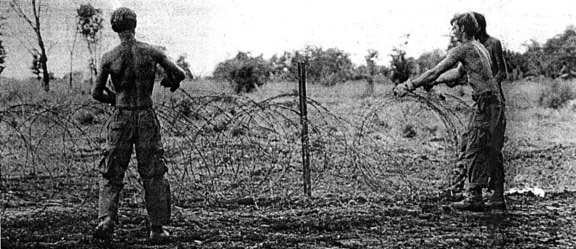
Page 6 TROPIC LIGHTNING NEWS September 7, 1970
12th Evac Lends
Medical Hand
Pacification Is Focal Point of American Effort
By PFC PATRICK F. MURPHY
CU CHI – Pacification has become a focal point of the American
involvement in Vietnam.
Lending valuable aid to Vietnamese civilians, thereby furthering the
pacification process, is one of the missions of the 12th Evacuation
Hospital’s out-patient clinic (OPC) at the 25th Division’s Cu Chi
base camp.
Under the direction of Sergeant First Class Ollie Nichols, the OPC provides a
variety of medical treatments designed to heal the ailing Vietnamese.
At the same time, a positive impression of the U.S. government is imparted on
these special patients.
"Almost 90 percent of the people we treat here were wounded by Viet Cong
booby traps," Nichols said. "We’ve been treating one papa-san continually
for over a year now," Nichols from Amarillo, Tex., went on. "His left side was
injured by a mine and he lost the left lung."
After repeated surgery and numerous visits to the clinic, the patient is well
on the road to recovery and a normal life.
"The possibility of this man becoming a Communist sympathizer is now
very remote," Nichols concluded.
The OPC is staffed by two permanent medical doctors and four medical
corpsmen. Periodic assistance is also received from members of the orthopedic, surgical
and neurological services.
Small children constitute a large percentage of the clinic’s patients.
Typical is the case of a 12 year-old Vietnamese girl who has been receiving treatment for
a foot injury resulting from a VC mine.
"Her wounds are healing up nicely," said Specialist 5 Arthur Wilks,
a medical corpsman. "Our biggest problem is getting the people to take proper care of
their injuries," Wilks said. "They just can’t walk through a rice paddie
with an open sore. Many times they fail to clean the wound between visits to the
clinic."
As constant cleanliness is a must to prevent infections, the OPC provides
various soaps and ointments to aid the people in the cleansing chores.
Want to Call Home? See Men from
Mars
By 1LT AL JOHNSON
FSB LYNCH – "There’s more to the mobile MARS operation than
just driving out into the field and plugging in," said Specialist 4 Ron Knight as he
swung the heavy field hammer on the steer grounding pin.
Knight and Specialist 4 Peter Kahlenberg completed the installation of both
rig and antenna within five hours and settled down to handle the scores of calls at Fire
Support Base Lynch.
Under the operational control of the 25th Division’s 125th
Signal Battalion, the mobile MARS (military affiliate radio station) began passing calls
on August 7 at Lynch.
As in past operations at field sites from Bearcat to Katum, the MARS field
rig is making it possible for men at distant field positions to speak with their families
in the United States. Transported on a two and one-half ton truck, the MARS van is capable
of setting up at practically any location in the 25th’s area of
operations.
"It’s really wild," one enthusiastic soldier exclaimed.
"here I am ten thousand miles from home, surrounded by M-16s, sandbags and the
monsoon and I just talked with my best girl in Baltimore. It was if she were next
door."
Utilizing stateside radio stations, MARS operators Knight and Kahlenberg can
place a field soldier in direct contact with any location in the continental United States
and Hawaii.
Back at division headquarters in Cu Chi, the 125th also maintains
a MARS station which is open around the clock. Of the thousand or more calls passed to the
United States in any given month, priority is given to Red Cross emergency messages and to
men from units on standdown.
Fast Cats Take On Clowns
By SGT DANIEL A. HOUSE
CU CHI – Under the watchful eyes of virtually no one, the 4th
Battalion, 9th Infantry’s S-1 shop held their first annual championship
basketball game here recently.
The teams were evenly balanced and stayed neck and neck throughout the first
half, but then the tide turned as "Finch’s Fast Cats" began to dominate the
play and quickly walked away from the frustrated "Clerical Clowns".
The "Cats", led by the considerable but agile Battalion X.O., Major
James T. Finch, were quick to discover weaknesses the second time around and drove in time
and time again – only to miss the shot.
The day was saved, however, by "Cats" star, 1st
Lieutenant William "The Golden Gun" Howell, the battalion adjutant, whose
relentless shooting finally found the mark.
Howell, of Lima, Ohio, whose style is strongly reminiscent of the late Velma
Glandburger, a one-time roller derby great for the Lima Lemurs, sums up his success this
way, "I’m not short".
Ask SGT Certain
DEAR SGT CERTAIN: When I was in a hospital in
Long Binh, I got to know a local citizen. We became good friends and this Vietnamese
friend expressed real interest in learning about American culture. I feel it would be good
for international relations if this civilian was allowed to live on Cu Chi base for
awhile. I would be glad to expend any extra effort involved myself. Do you think you could
help me swing this great people-to-people project?
P.Score
DEAR P: It depends. Does she have a sister?
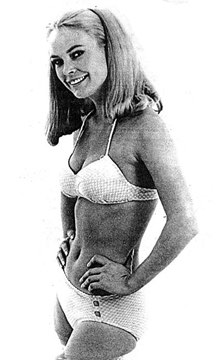 DEAR SARGE: When I got to Vietnam, I grew a moustache.
My wife says if I don’t shave it off, she will grow one too. She can. What’ll I
do?
DEAR SARGE: When I got to Vietnam, I grew a moustache.
My wife says if I don’t shave it off, she will grow one too. She can. What’ll I
do?
SFC Hir Sute
DEAR SFC: Make sure both are well-trimmed and
don’t exceed the corners of the mouth.
DEAR SGT CERTAIN: My platoon sergeant found my
hidden collection of pinup pictures and took me to see the CO. The CO brought me to his
office and showed me his collection as well as a few he had on loan from the battalion
commander. When I told my platoon sergeant what happened he said we were all
"dirty" and then went to his hootch and cried. How can I console the poor guy?
Soft Core
DEAR SOFT: Tell the poor sarge you didn’t
really mean it. The pictures were just there to keep the dust off your comic books. Find
him a copy of "Batman meets Archie and Veronica." He’ll know your
heart’s in the right place.
ONE VOTE FOR THE BLOND – As we were electing our TLN girl of the week, a very important day came to mind. DEROS? No, election day back in the world. If you haven’t obtained your absentee ballot as yet, contact the voting officer in your unit. Time is running out.
Page 7 TROPIC LIGHTNING NEWS September 7, 1970
Figuring the Location
They Work the Angles
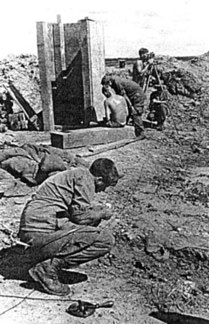 Story and Photo By SP5 DOUG SAINSBURY
Story and Photo By SP5 DOUG SAINSBURY
CU CHI – When an artillery radar section moves to a fire support
base, foremost in the minds of the radarmen is the crucial question "exactly where
are we?"
There is no cause for anxiety, though. Before the radar or guns ever roll
into the base, an artillery survey team goes to the new location to calculate the exact
grid coordinates of the point where the radar or howitzers are to be emplaced.
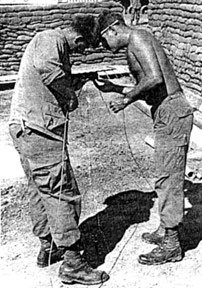 The survey team of the 2nd Battalion, 77th
Artillery recently set up their equipment at Fire Support Base Snyder, northeast of here,
to compute data for the battalion’s radar section.
The survey team of the 2nd Battalion, 77th
Artillery recently set up their equipment at Fire Support Base Snyder, northeast of here,
to compute data for the battalion’s radar section.
Starting from a previously established control point, the crew oriented its
location by computing the direction and distance to a second known landmark.
"We like to use Nui Ba Den (Black Virgin Mountain) or the sun as our
second known landmark whenever possible," said Sergeant First Class Neil Orness of
Lake City, Iowa, chief of the Up Tight survey section.
"We always know the grid coordinates of the survey control point and the
second landmark, and then we calculate the direction and distance between the two. This
gives us the data we need to establish our other survey stations which will eventually
take us to the point where the radar is to be placed."
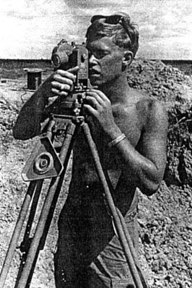 Nui Ba Den and the sun were both hidden by clouds on this particular day, so the team had
to use a nearby 120 foot tower for its second landmark.
Nui Ba Den and the sun were both hidden by clouds on this particular day, so the team had
to use a nearby 120 foot tower for its second landmark.
The crew uses a complex instrument called a theodolite to measure the angles
between the successive survey stations. Then two surveyors, known as computers, take this
data and apply geometric and trigonometric principles to determine the exact direction for
each station. Each computer acts as a check on the other to insure accuracy.
Simultaneously, two other crew members, known as tapemen, stretch a 30-yard
steel tape between stations to measure distance.
All of the calculations give the team the grid coordinates of each new survey
station. The last leg of the survey is from the final survey station to the point where
the radar will be set up.
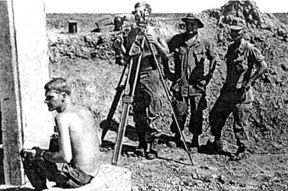 As an insurance check for accuracy, the team measures the angle from the radar location to
either the initial control point, or the second known landmark.
As an insurance check for accuracy, the team measures the angle from the radar location to
either the initial control point, or the second known landmark.
"Our particular survey section works under an allowable error of one
tenth of one mil for direction (there are 17.8 mils in one degree) and one one-thousandth
of whatever unit we happen to be using for distance," Orness said.
When the radar section moves to its new location here, it will know its grid
coordinates and the exact direction to the 120 foot tower, thus enabling the radarmen to
provide the howitzers with accurate data on enemy activity and locations.
Photo Captions:
Left top: PULLING TAPE – Specialist 5
Jerry Pyles of Springfield, Ohio (foreground), a member of the 2nd Battalion,
77th Artillery survey section measures the distance between two survey stations
as other members of the team gather more data.
Right top: HAIRLINE – Sergeant Bob
Forbes, of Iowa City, Iowa, a member of the 2/77 Arty survey section uses a theodolite to
measure the angle between two survey stations.
Left bottom: PRECISION –
Specialist 5 Jerry Pyles, of Springfield, Ohio (left), and Specialist Ed Szymanski, of
East Hartford, Conn., members of the 2nd Battalion, 77th Artillery
survey section take a reading from a 30 meter steel tape.
Right bottom: PROPER FIGURES –
Specialist 4 Bill Horton, of Greensville, Miss. (lower left), waits for other members of
the team to measure the angle between two survey stations, so that he can record the data.
Page 8 TROPIC LIGHTNING NEWS September 7, 1970
Advance to the Rear
AIT Training Comes in Handy
By SP4 GARY PETERSON
DAU TIENG – A small 25th Division recon patrol found out
recently that the training soldiers receive in AIT definitely pays off.
Sergeant Robert Silva, of Petaluma, Calif., was in charge of a reconnaissance
patrol from Company A, 2nd Battalion, 14th Infantry Golden Dragons,
looking for a night AP (ambush patrol) site. Shortly after starting out, they came upon a
clearing and spotted a VC walking through it.
"Our pointman opened up on him first, then we all got on line and
started firing too," Silva said. "About that time, we started to receive fire
from four or five positions around the clearing and I realized that we had walked into an
ambush."
The patrol quickly hit the ground and returned fire until their ammo started
running low, and it became obvious that they would have to pull back and call in support.
"Our retreat was beautiful, just like we used to practice on assault in
AIT, only backwards," said Private First Class Wendel Ratliff, of Portsmouth, Ohio.
"One man would fire a few rounds, then get up and run back a ways while the others
laid a base of fire. Just like the old "Bravo team, prepare to move out! Move out!
stuff in training. It really worked and no one got hurt."
After several minutes of maneuvering, the men made it up a trail, where they
sprayed the area with M-16 fire and called in artillery from an old VC bunker.
Pointman, Specialist 4 James Baker, of Brewton, Ala., summed up the afternoon
by saying, "I always knew that staying awake in training classes would pay off
someday. I’d hate to think what would have happened if everyone had tried to get away
at once."
Bautz Presents Award
725th Cited For ‘Fine Job’
By SP5 TOM WATSON
CU CHI – By order of the secretary of the Army, the 25th
Division’s 725th Maintenance Battalion has been awarded the Meritorious
Unit Commendation for exceptionally meritorious achievement in the performing of
outstanding service.
The award was for the period from February 15, 1969 to August 15, 1969.
Acting in behalf of the secretary of the Army, Division Commander Major
General Edward Bautz Jr., presented the commendation to the men of the 725th.
Almost half of the soldiers present at the ceremony were members of the unit
during the time cited in the award.
"Fine Job"
Bautz expressed his personal appreciation to the 725th for doing a
"fine job and bending over backwards to help other units."
According to the citation, the "Service to the Line" battalion
exemplified diligence, initiative and professional expertise by providing direct support
maintenance to the 25th Division.
Purely Physical
Through purely physical efforts, the officers and men improved existing
facilities and built new facilities for themselves and their customers, according to a
unit spokesman.
Included in this revamping were the erection of new buildings, rewarehousing
and elevation of open storage for proper drainage at tech supply.
New Procedures
Administratively, the 725th improved its existing supply and
maintenance procedures to insure better customer service.
Included in this administrative improvement was the return to the depot of
more than a million dollars worth of low-demand items.
While the supply aspects of the battalion were being improved, the
maintenance backlog was going down continually.
Contact Teams
One factor that lowered the backlog was the dispersing of contact teams
through the 25th Division’s area of operations. This resulted in the
lowest possible down time for the equipment.
By the end of the period, the division had the use of better than 99 per cent
of its equipment, according to the division material office.
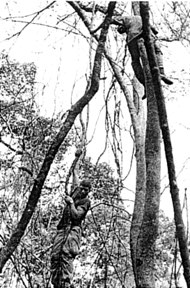 MONKEY BUSINESS – Two
members of Alpha Company, 1st Battalion, 27th Infantry climb a
nearby tree to get a better view of the surrounding countryside. (Photo by SGT Jack
Strickland)
MONKEY BUSINESS – Two
members of Alpha Company, 1st Battalion, 27th Infantry climb a
nearby tree to get a better view of the surrounding countryside. (Photo by SGT Jack
Strickland)
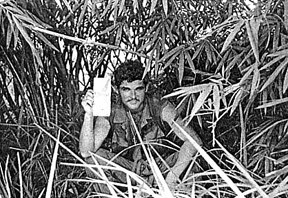 THE WORLD IN HIS HAND
– Clutched in the hot little hand of SP4 Gary Tanner is his ticket back to the world.
Tanner is an infantryman with the division’s 2nd Battalion, 12th
Infantry. (Photo by SGT Mark Rockney)
THE WORLD IN HIS HAND
– Clutched in the hot little hand of SP4 Gary Tanner is his ticket back to the world.
Tanner is an infantryman with the division’s 2nd Battalion, 12th
Infantry. (Photo by SGT Mark Rockney)
Opens Up on Enemy
Dragon Newbie Baptized
By SP4 GARY PETERSON
DAU TIENG – Every new man in country wonders how he will react the
first time he comes face to face with the enemy. A new 25th Division trooper
recently found out.
Private First Class Les Bechdel, from State College, Pa., joined Company A, 2nd
Battalion, 14th Infantry Golden Dragons, about a month ago and hadn’t seen
any action his first few times in the field.
"The thought of actual combat with another man always bugged me,"
Bechdel said. "I thought I could react properly, but you always hear stories of guys
freezing up and all."
Bechdel was walking with the point element of the Dragons on a recent sweep
of some NVA bunker complexes. As the unit broke out of a woodline, the "newbie"
spotted a VC soldier squatting next to a bomb crater.
"At first, I kind of just froze and started to tell the pointman I had
spotted a VC," Bechdel reflected. "Then it hit me that I had better start
shooting before he did."
He opened up on the enemy soldier with his M-16 rifle, and the rest of the
element quickly followed suit.
The results of the action: one VC killed, one Chi-Com hand grenade captured
and one new man ready for action any time the need arises.
SUPERCAP Big Hit At Cam My
Village
By SGT MIKE KEYSTER
CAM MY VILLAGE – MEDCAPs (Medical Civic Action Programs) have been
going on in Vietnam for a long time, but recently, the 25th Division’s 2nd
Brigade Psychological Operations (PSYOPS) Section came up with something new – the
SUPERCAP.
A SUPERCAP is an internationalized MEDCAP where not only medical aid but
dental care, gifts, candy, soap and movies are provided to the Vietnamese people.
The medical aid portion of the SUPERCAP was provided by the medics of the 4th
Battalion (Mech), 23rd Infantry. With the aid of Vietnamese interpreters, the
medics diagnosed and treated a wide variety of ailments.
Meanwhile, in keeping with the spirit of working together, a contingent of
Australians, led by Captain Alan Johnston, provided dental aid.
Throughout the afternoon, Tomahawk GIs handed out large amounts of candy,
washing detergent, South Vietnamese flags and dental care kits to the pressing crowd.
Eager children swarmed the GIs several times in their scramble for the gifts.
After those needing medical and dental attention were treated, a PSYOPS team
took over. The team provided entertainment in the form of motion pictures which the
villagers seemed to enjoy.
Thanks to
Ron Leonard, 25th Aviation Bn., for locating and mailing this issue,
Kirk Ramsey, 2nd Bn., 14th Inf. for creating this page.
This page last modified 8-12-2004
©2004 25th Infantry Division Association. All rights reserved.